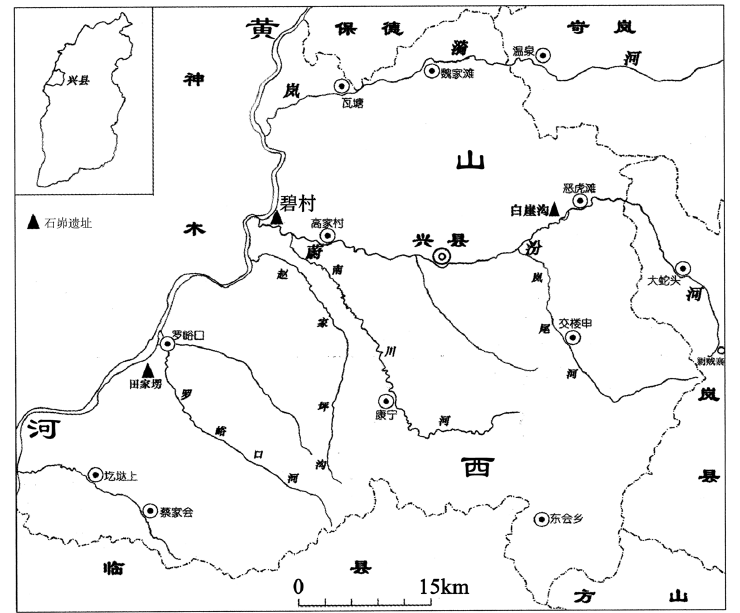

收稿日期: 2018-05-15
网络出版日期: 2020-07-17
基金资助
本文是“十三五”重点项目“河套地区聚落与社会研究”阶段性研究之一,得到国家文物局2016年度重点文物保护专项的资助
A study of stone artifacts excavated at the Bicun site in Xingxian county
Received date: 2018-05-15
Online published: 2020-07-17
任海云 , 王晓毅 , 王小娟 , 张光辉 . 山西兴县碧村遗址石器研究[J]. 人类学学报, 2020 , 39(01) : 52 -63 . DOI: 10.16359/j.cnki.cn11-1963/q.2019.0018
In China, neolithic archaeologists spend more time studying the grinding stone tools. For instance, some researchers have focused on their fabrication process and use of the grinding stone tools recently. However the study on the hammering stone artifacts have been ignored although a number of them were found in the neolithic sites, especially the Longshan time sites. In this paper we made an observation of all the stone artifacts excavated at the Bicun site, especially analyzed the hammering stones, which were excavated in Xingxian county, Shanxi province during 2015 to 2017. It is characterized with abundant flakes and fragments, as well as tools including a variety of scrapers, bifaces, arrow-heads and awls. Flakes were preferred to be chosen for retouching into tools. Bifaces were too highly retouched to recognize the blanks. Hard hammer percussion was used in reductions and retouching, and suppression was used in retouching as well. The griding stone axes also could be used as hammers. Raw materials were selected from near the Yellow River and Weifen river beaches. Producing stone artifacts is only a small item of handicraft industry, and it has declined, but the existence showed a strong vitality of the small stone tool cultural tradition. Some tools such as arrow-heads and points indicated that hunt-gathering was an auxiliary living way.

Key words: Bicun site; Longshan times; stone artifacts; small stone tool tradition
| [1] | 山西省考古研究所, 等. 2015年山西兴县碧村遗址发掘简报[J]. 考古与文物, 2016,4:25-33, 87 |
| [2] | 山西省考古研究所, 等. 2016 年山西兴县碧村遗址发掘简报[J]. 中原文物, 2017(4):4-17 |
| [3] | 王建, 王益人 . 石片形制探究——旧石器研究的一种新的理论与方法[J]. 考古与文物, 1988(3):12-30 |
| [4] | 陕西省考古研究院,榆林市文物考古勘探工作队,神木县文体广电局. 陕西神木县石峁遗址韩家圪旦地点发掘简报[J]. 考古与文物, 2016(4):14-24 |
| [5] | 中国社会科学院考古研究所, 山西省临汾市文物局. 襄汾陶寺——1978~1985年考古发掘报告[R]. 北京: 文物出版社, 2015 |
| [6] | 中国社会科学院考古研究所山西工作队, 临汾地区文化局. 1978—1980年山西襄汾陶寺墓地发掘简报[J]. 考古, 1983,1:30-42 |
| [7] | 翟少冬, 王晓毅, 高江涛 . 山西陶寺遗址石制品及相关遗迹调查简报[A].中国社会科学院考古研究所. 考古学集刊(19)[C]. 北京: 科学出版社, 2013: 1-26 |
| [8] | 翟少冬 . 陶寺遗址石制品复制实验与工艺研究[J]. 人类学学报, 2015,34(2):192-201 |
| [9] | 王晓毅 . 襄汾陶寺遗址石器工业的实验考古研究[A]. 山西省考古研究所.砥砺集——丁村遗址发现60周年纪念文集[C]. 太原: 三晋出版社, 2017: 224-248 |
| [10] | 陈宥成, 曲彤丽 . 两面器技术源流小考[J]. 华夏考古, 2015(1):18-25 |
| [11] | 王建, 王向前, 陈哲英 . 下川文化——山西下川遗址调查报告[J]. 考古学报, 1978(3):259-288 |
| [12] | 山西临汾行署文化局. 山西吉县柿子滩中石器文化遗址[J]. 考古学报, 1989,3:305-323 |
| [13] | 山西大学历史文化学院,山西省考古研究所. 山西吉县柿子滩遗址S29地点发掘简报[J]. 考古, 2017(2):35-51 |
| [14] | 王向前, 丁建平, 陶富海 . 山西蒲县薛关细石器[J]. 人类学学报, 1983,2(2):162-171 |
| [15] | 谢飞 . 籍箕滩旧石器晚期细石器遗址[J]. 文物春秋, 1993(2):1-2 |
| [16] | 谢飞, 李珺, 刘连强 . 泥河湾旧石器文化[M], 石家庄: 花山文艺出版社, 2006: 185-189 |
| [17] | 盖培, 卫奇 . 虎头梁旧石器时代晚期遗址的发现[J]. 古脊椎动物与古人类, 1977,15(4):287-300 |
/
| 〈 |
|
〉 |